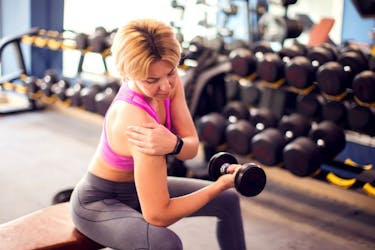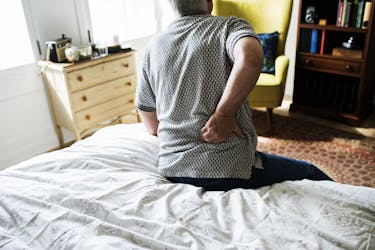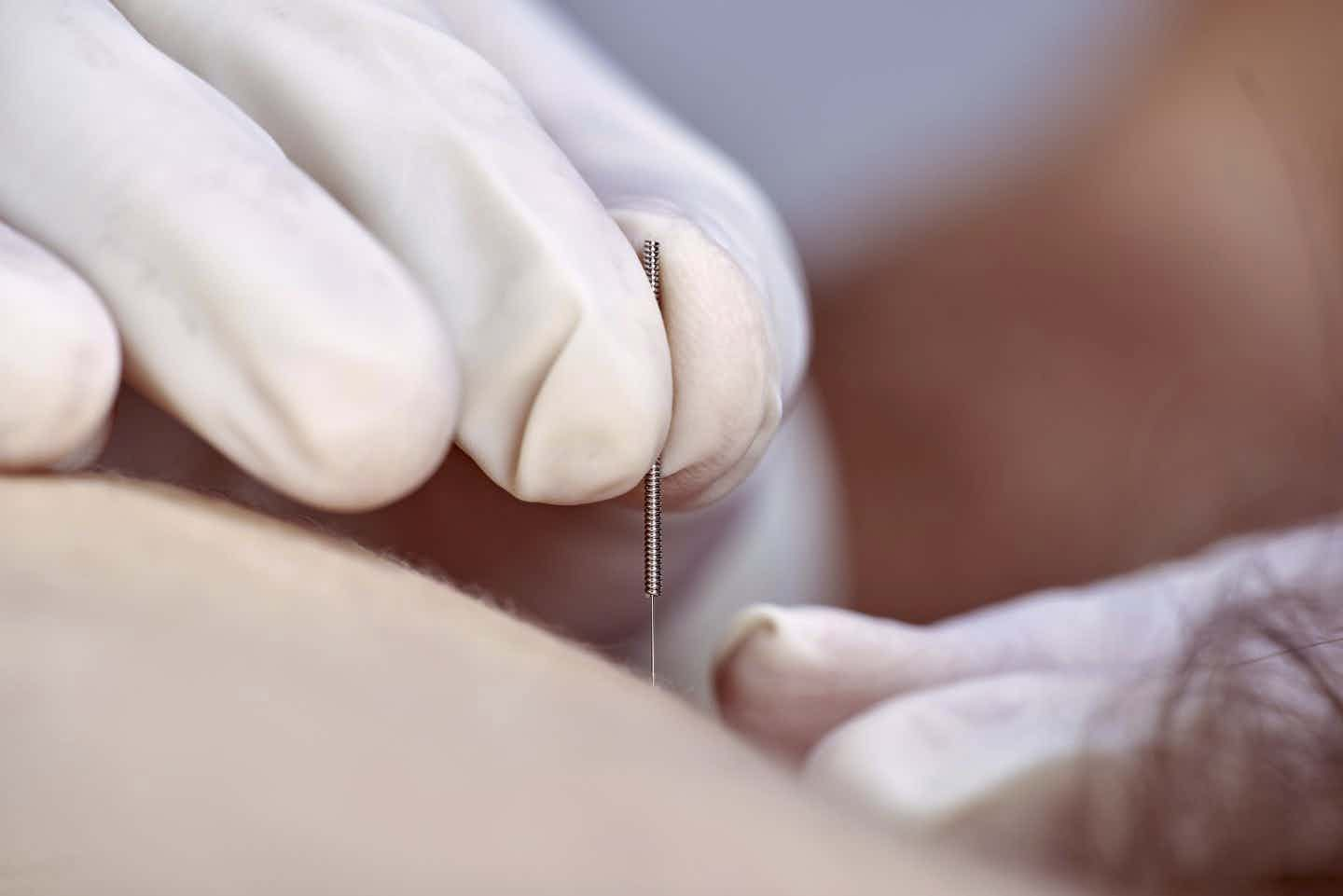Because we understand every patient experience is unique, we start with a conversation to better understand where you are and how we can help you get to where you want to go. This process is important because not all pain is the same (individual's not the same also). Understanding how long you have been in pain helps us to facilitate your recovery in the quickest way possible.
We've developed an algorithm of treatment based upon tissue healing times and pain neuroscience to help you feel more empowered in your recovery. Our approach to pain is different based upon whether you have had an injury or how long you have been experiencing symptoms.
INJURY OR SURGERY INSIDE OF 3 MONTHS

Acute pain (injury or surgery inside of 3 months)
- Typically associated with tissue damage that occurs when the amount of force or load exceeds the tissue’s capacity. All tissues heal but some heal faster than others based on their physiological makeup and amount of blood supply. Therefore tendon, muscle, and cartilage injuries all recover differently and often require varied treatment approaches.
- Key components of rehabilitation during this phase include protection, pain modulation, and controlled exercise. Your fastest recovery occurs with optimal loading where your activity matches your tolerance. All tissues respond and get stronger with controlled stress. See reference links.
- Wolff’s law: https://www.verywellhealth.com/
- Davis’ law: https://en.wikipedia.org/
- SAID principle: https://en.wikipedia.org/wiki/
- Total gyms (coming soon)
- AlterG (coming soon)
- Lat bar with unloading (coming soon)
- Steen pulleys (coming soon)
- Pilates (coming soon)
Your feedback and reported response to treatment during this phase is critical in making sure you get the best outcome. We will be progressing your exercises and activity regularly while at the same time obtaining feedback from you on your response to treatment while making any necessary changes. Think of the Goldilocks principle: not too hot, not too cold. In this instance, too little activity will not force adaptation of the tissue, while too much activity can cause overload resulting in pain, swelling, and tissue failure. We work closely with you to prescribe just the right dosing of activity to achieve the best results. At 3DPT not only are you guided by highly trained physical therapists, but we utilize state of the art equipment to facilitate an optimal healing environment. These tools are essential in matching your activity with your tolerance. See some examples below of how we use specialized equipment to achieve pain free functional exercises ultimately expediting your recovery.
PAIN LASTING LONGER THAN 3 MONTHS

Chronic pain (pain lasting longer than 3 months)
- Pain is a powerful tool that helps us to navigate through life and detect danger. It lets us know when there is something out there that can cause harm to our body. The brain and our nervous system are our natural source of protection. When our nervous system is working properly our tissues send danger signals to the brain when there is a potential threat, and the brain interprets whether that signal is actually threat by giving us pain to make sure we remove ourselves from the danger. Normally our nervous system should calm down after the threat is over, but sometimes it remains in a state of hypersensitivity ultimately keeping us in a chronic pain state. Watch this 3-minute video for a more detailed explanation. Adriaan Louw: Persistent Pain Explained https://www.youtube.com/watch?v=jyHeAQbFs34
- Sometimes even though the tissues have healed, pain persists. This is typically more related to an ongoing hypersensitivity of the nervous system and has less to do with tissue damage. We are complex individuals and there are many factors that play into our pain experience. Watch the videos below to get a better understanding of chronic pain and why it happens. Understanding pain in 5 minutes: https://www.youtube.com/watch?v=cLWntMDgFcs
https://www.youtube.com/watch?v=jIwn9rC3rOI - Body’s alarm system (leaf blowing by house vs breaking window)
- Chronic pain can wreak havoc on a person’s sense of autonomy. With no clear understanding of pain science, those suffering with chronic pain can go from feeling empowered in their circumstances to feeling fearful, hopeless, and depressed ultimately becoming dependent upon various medical providers for answers and a cure. It can lead you down a rabbit hole of various treatments and interventions with no real progress. It’s up to your medical professionals to first rule out any other (medical cause) for the pain you are experiencing. Once other causes are ruled out, education is the key to arming you with information and a plan to get you back on track. As Adriaan Louw puts it, “Knowledge provides far better outcomes than the most powerful drugs prescribed.” The outcome we strive for amongst our own team: empowerment and happiness, is also the outcome we want for you. Below is an excellent video on Treating Pain Using the Brain by David Butler (DIMs vs SIMs) Be a SIM hunter! https://www.youtube.com/watch?v=4ABAS3tkkuE
- In addition to providing pain science education we incorporate treatment techniques to help modulate your nervous system, reduce pain, and improve your overall function. Every person’s pain experience is unique, so we figure out which evidence-based treatments are most effective for you based on your response to treatment. Below are just a few examples of various treatment techniques we use here at 3DPT.
- For the most severe pain we may begin with treatment interventions that focus on changing the sensitivity the brain by using non movement-based interventions like GMI.
- Right/Left Discrimination (Recognize apps)
- Visualization
- Mirror therapy
- Sensory exercises: 2 pt discrimination
- Hands on treatment interventions (Manual Therapy)
- Instrument Assisted STM
- Joint mobilization/manipulation
- Dry Needling
- Exercise
- It’s Okay to Move!
- Graded Exposure to exercise is one of the best things you can do to regulate the nervous system and reduce pain.
- With chronic pain the tendency is to stop movement. What are some factors that create fear of movement?
- Imaging: Many times imaging may show findings that are typical in patients who don’t have pain. For example 68% of 40 y/o have degenerative disc disease and 50% have disc bulging with no symptoms. Imaging is most helpful to rule out more serious conditions after injury and is also most helpful when the results are consistent with a good physical exam.
- With chronic pain there may be some discomfort with treatment but it’s important to understand you are not causing damage to the tissue.
- The goal is to balance progress of activity with your response. For example if you have mild discomfort after a session, it’s okay to continue progress. If there is a significant increase in severity or duration of pain, we would adjust the activity to stay within your tolerance. Remember the goal is to train the brain to get more familiar with the body and bring the nervous system back to a state of normal sensitivity.
- Descending inhibition change in cortical representation, stress reduction.
- Smudging: somatosensory cortex Explains the brain’s anatomy homunculus.
At 3DPT you’ll experience a systematic approach to treatment based on our company values and guiding principles combined with current best clinical practices.
MANUAL THERAPY INTERVENTIONS

Dry Needlingis a mechanism for reducing trigger points throughout the body. The best way to think about it is like driving on a highway. If there is a slow car in front of you, then you pass them. By passing them, you use…or overuse…other lanes. So that break down in other lanes is caused by a disruption elsewhere.
This analogy works as muscles have a defined number of fibers. They can get bigger, and can get smaller, however they cannot be removed unless they are removed.
With trigger point dry needling we remove that barrier from the muscle fiber and allow for all fibers to work in unison. This will allow muscles to work as intended, decreasing pain and increasing performance.
We can also stimulate a healing response with dry needling. We use a process called‘pistoning.’ Pistoning is a process when the needle is positioned in various areas to kick start thehealing process. This is similar to when you were a kid and the doctor had to rebreak your armto allow it to heal correctly.
Dry Needling uses a sterile acupuncture needle that is inserted through the skin into muscles,tendons, ligaments, and/or close to nerves to immediately reduce pain, decrease muscletension and increase mobility. Dry Needling is not acupuncture; it is based on a modernscientific study of musculoskeletal and neuromuscular systems. This treatment techniqueprovides an environment that enhances the body’s ability to heal which ultimately reducespain.
Cupping

Cupping is a traditional Chinese medicine (TCM) practice that involves placing cups on the skin to create suction. This practice dates back over 2,000 years but has received recent attention due to its use by world-class athletes for injury relief.
The cups used in cupping are typically made of bamboo, glass, or earthenware.
It’s believed that the effect of suction on the skin helps increase blood flow and promotes healing; however, the way in which cupping may have an effect on the body is unclear. A study in PLoS One researchers concluded that cupping could be effective in treating the pain and disability associated with chronic neck pain and chronic low-back pain in the short term.
Cupping is generally safe for healthy people when performed by one of our trained health professionals.
Some of the side effects like bruising and soreness are possible.
Ask your physical therapist how cupping might help you.
Cupping is a helpful alternative treatment for some. Please share your complete health history with your therapist and they will discuss the benefits and possible side effects of cupping to make sure it is right for you.
Call Us Today for More Information
IASTM is a modern manual therapy technique used to treat individuals diagnosed with soft tissue abnormalities. It is performed with ergonomically designed instruments that detect and treat fascial (connective tissue) restrictions to effectively treat areas with soft tissue fibrosis (the formation of excess fibrous connective tissue in an organ or tissue in a reparative or reactive process to injury or damage - excessive scar tissue), chronic inflammation or degeneration.
Using ergonomically designed hand-held instruments, IASTM clinicians comb over the skin to find soft tissue problems. Then, the instruments are used with the appropriate amount of pressure to introduce controlled microtrauma to the area. Controlled microtrauma initiates reabsorption of fibrosis (excessive scar tissue) and facilitates healing as adhesions in the soft tissue are broken down, allowing restoration of full function.
There are several IASTM methods used by clinicians today, including Graston Technique, HawkGrips, Sound Assisted Soft Tissue Mobilization (SASTM) and Fluid Motion Soft Tissue Tools (FMST).
Graston Technique, HawkGrips, and FMST Tools use steel instruments that glide along the muscle, tendon or ligament. The application of a specified amount of pressure allows the clinician to discover the location of the scar tissue or restrictions. The instruments are then used to break up the restriction to help the patient recover range of motion and functionality.
SASTM works in a similar manner, except that the instruments locate restrictions through sound waves. Then, the tissue is treated with the appropriate amount of applied pressure. Some people have reported noticeable improvements after only one treatment. But most need 8-10 treatments over the course of a few weeks. No medications are required.
What to Expect
Prior to IASTM treatment, patients may be advised to complete five minutes of cardiovascular activity, such as riding a stationary bike or walking on a treadmill. Then, ultrasound or heat treatment may be applied to the injured area to warm up the soft tissue.
During the treatment, the clinician will use the hand-held instruments to scan, then treat the affected area using very specific, calculated massage techniques over the affected area(s). Treatment usually lasts 30 to 60 seconds over each area treated. Some discomfort may be felt during treatment, and there may be some bruising and small red dots over the area that was treated (called petechiae). If this happens, ice application to the affected area for about 15 to 20 minutes following treatment will probably ease the discomfort.
IASTM is generally done in conjunction with an exercise, stretching and strengthening program for rehabilitation to help the injured tissues heal.
Conditions Treated
IASTM is an effective treatment option for a variety of conditions including:
- Medial Epicondylitis (golfer's elbow)
- Lateral Epicondylitis (tennis elbow)
- Carpal Tunnel Syndrome
- Neck Pain
- Plantar Fascitis (foot pain)
- Rotator Cuff Tendinitis (shoulder pain)
- Patellar Tendinitis (knee pain)
- Tibialis Posterior Tendinitis
- Ankle Pain / Foot Pain / Heel Pain / Achilles Tendinitis
- DeQuervain's Syndrome
- Post-Surgical and Traumatic Scars
- Myofascial Pain and Restrictions
- Musculoskeletal Imbalances
- Chronic Joint Swelling Associated with Sprains/Strains
- Ligament Sprains
- Muscle Strains
- Non-Acute Bursitis
- Complex Regional Pain Syndrome (CRPS) / Reflex Sympathetic Dystrophy (RSD)
- Back Pain
- Trigger Finger
- Hip Pain (Replacements)
- IT Band Syndrome
- Shin Splints
- Chronic Ankle Sprains
- Acute Ankle Sprains (Advanced Technique)
- Surgical or Traumatic Scars
Many people have reported increased range of motion (ROM) and reduced pain after the first IASTM treatment. IASTM has been proven successful in reducing scar tissue problems from surgical and traumatic scar tissue and achieving great results with pain control and rejuvenating joint, ligament, tendon and muscle flexibility.
Call us today for more information on IASTM or to set up an appointment.
